Engineering for All
Inaugural Dean’s Innovation Fund grant brings middle-school students to W&M for Camp EAGER
September 2, 2021
By
Julie Tucker ’01
On a blistering hot day in August, the courtyard of the School of Education became a busy testing pad, launching dozens of rockets engineered from plastic soda bottles. The engineers were a group of middle-school students from Newport News Public Schools (NNPS), attending Camp EAGER as the culminating experience of their five-week summer school session. The children, identified as needing remediation after a year of learning disrupted by COVID, were completely absorbed in the task at hand, consulting with their college-aged mentors about the aerodynamics of their designs and joking with friends about whose rocket would fly highest. When one of the rockets made a crash landing on the highest rooftop of the school building, the crowd erupted in raucous applause.
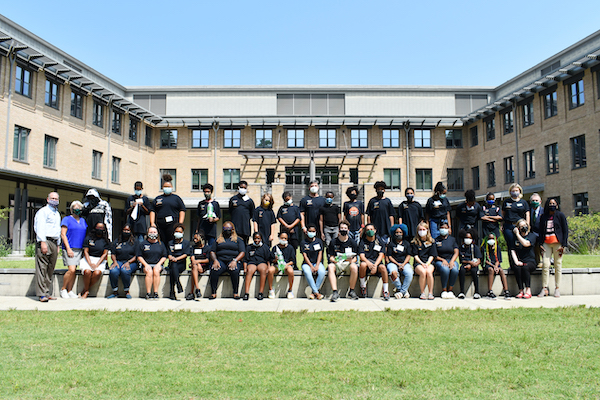
Camp EAGER is the brainchild of the Center for Innovation in Learning Design (CILD), co-directed by Meredith Kier, associate professor of science education, and Lindy Johnson, associate professor of English education. EAGER stands for Elevate engineering, Advance innovation, Guide Learning, Effect change, and Remove barriers for all. The camp was designed to explore two thorny and persistent problems in the STEM field: firstly, how can we encourage more people from underrepresented groups, primarily girls and youth of color, to pursue STEM careers? And secondly, how do we prepare them to work collaboratively and communicate effectively with diverse stakeholders?
“We’re looking for ways to not only inspire an interest in science and math, but also to give them the communication skills they need to share their ideas, make compelling arguments and collaborate with others,” said Kier.
A powerful mentoring model
A unique aspect of the camp is the strategic use of mentoring. Through a partnership with the National Society of Black Engineers, Kier and Johnson recruited undergraduate majors in STEM fields from underrepresented backgrounds to serve as mentors to the middle-school students. Not only are these mentors near in age and experience to the campers, they also have diverse expertise in engineering that sparks new ways of thinking among both students and teachers.
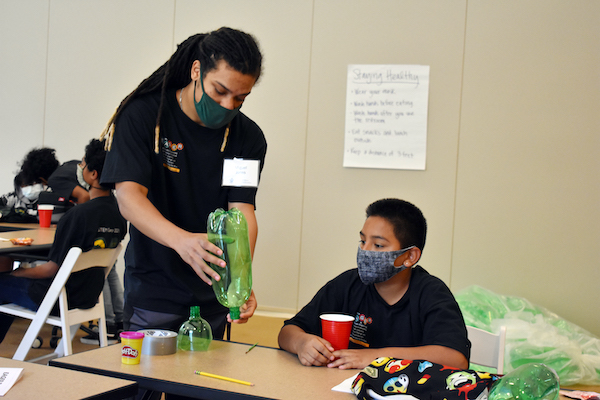
Over the past two years, CILD has been exploring the potential of this approach through a grant from the NSF. They’ve been working with undergraduate mentors and teachers in Newport News to co-design engineering challenges based on real-world problems. When the center’s partners in NNPS expressed a desire to expand their summer-school curriculum with an off-site, hands-on experience, Camp EAGER was born.
“Our partnership with NNPS has been so positive and mutually beneficial thanks to their openness to new ideas and their equity-driven values,” said Kier. “They will always work toward yes and they truly have the kids at heart."
The collaboration between university and school division resulted in a truly impactful experience for the children, said Tami Byron, STEM instructional supervisor in NNPS. “The excitement amongst the students when engaging in the hands-on STEM learning experiences with their peers was especially encouraging after many months of computer-based learning,” she added.
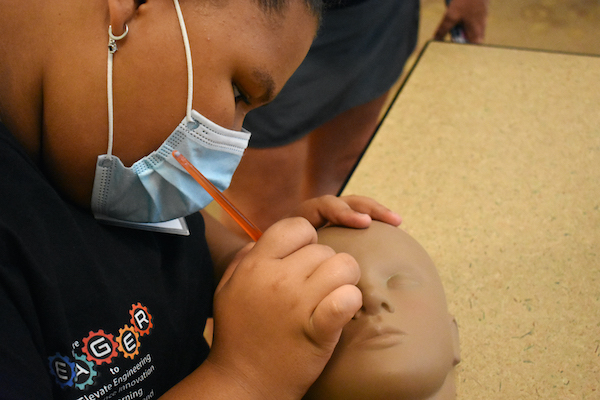
The week-long camp brought the middle-school students to the W&M campus to explore one of two engineering challenges: design and launch a bottle rocket or create their own line of all-natural cosmetics. Kier and Johnson developed interactive engineering design notebooks to guide the campers and mentors through the challenges. Embedded in these activities were learning strategies carefully crafted to guide the students’ understanding of the design process.
“These strategies are really about helping the mentors, who have expert content knowledge, model their own thinking and communication skills so that they apprentice the middle-school students into ways of thinking, speaking and writing like scientists and engineers,” said Johnson.
The undergraduate mentors were trained to not only lead the camp and support the middle-school students in their learning, but also to be action researchers, taking field notes and collecting data as they interacted with the campers.
Serving as a mentor was a powerful experience for Faith Odom ’22, a senior psychology major at William & Mary. Although she hasn’t yet decided on a career path, participating in the camp affirmed her interest in working with children. “And the camp introduced me to many faculty who are open and willing to help me navigate my next steps after graduation,” she added.
An interdisciplinary, whole-child approach
A year and a half into the pandemic, the team knew that attending to the campers’ social-emotional wellness would be critical to the success of the camp. Janise Parker, assistant professor of school psychology, developed special activities and supports to promote community-building and help the mentors build positive relationships with the campers.
“We especially wanted to train the mentors to identify and acknowledge the students’ strengths and to convey a sense of care for the youth by listening, seeking their input when relevant and showing up both physically and mentally for the children,” said Parker.
She added that it was easy to observe the benefits of the camp for both campers and mentors.
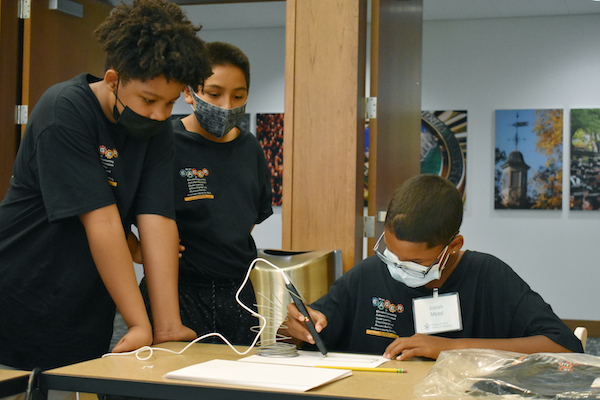
“It is so compelling to see how children who are historically marginalized blossom in a hands-on, culturally responsive learning environment,” she said.
The mentors not only learned how to communicate complex concepts to students from diverse backgrounds, they also became more aware of the needs and experiences of marginalized students in educational settings.
“This kind of service-learning experience prompts individuals to think about the structural and systemic conditions that produce inequity, leading them to continue to fight for social justice in their professional and personal lives,” said Parker.
A collaboration fueled by philanthropic support
For Dean Rob Knoeppel, the camp is an exciting example of his vision for the School of Education. A year into his tenure as dean, Knoeppel has set an ambitious course to expand the school’s impact through community collaboration and transformative research.
“This project really epitomizes what we mean by community-engaged teaching and research,” said Knoeppel. “It brings together teachers, researchers, students and the community to learn from one another. It unites university and K-12 in the pursuit of new and better ways to educate. And it advances our understanding of equitable teaching practices. This is exactly what we’re called to do.”
Last year, the Dean’s Innovation Fund was established thanks to a generous gift from Shelley and Thomas Jennings, along with their daughter Kathleen Jennings ’08. The Jennings family has been stalwart supporters of the School of Education; they established the Jennings Family Scholarship Endowment in 2011 to support W&M students training to become teachers. Shelley is a former trustee of the William & Mary Foundation and Kathleen served on the School of Education Development Board from 2014-2020.
With a new $500,000 gift in 2020, the Jennings provided both immediate funds to kickstart the school’s strategic priorities and an endowment that will ensure long-term funding for future initiatives. The Dean’s Innovation Fund will annually support projects designed by faculty to expand the school’s impact and innovative partnerships.
“We were thrilled when we learned that Camp EAGER was selected as the inaugural recipient of a grant from the Dean’s Innovation Fund,” said Kathleen Jennings. “We hoped to facilitate partnerships that leverage the expertise of the school to make a real impact on the lives of children and families. This project certainly fits the bill — and more.”
Looking forward
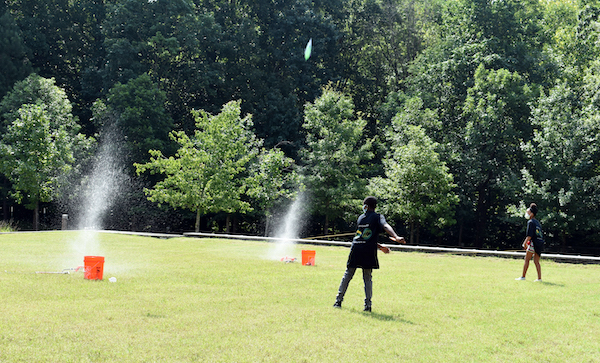
The innovation grant provided funding for two years, so while the team is busy analyzing data and examining their findings, they’re already making plans for next year’s camp. They hope to double the number of participants, add new engineering design challenges, refine the literacy strategies and provide more training for mentors to facilitate the camp experience.
“We also want to give the students more opportunities to experience the university campus setting, especially the many places and ways in which STEM learning takes place,” said Kier. “We really want to help them see themselves on a college campus.”
As the last of the rockets were launched and the campers prepared to return home on the last day of camp, Kier, Johnson and Parker reflected on the week’s experiences.
“This is exactly what summer school should look like,” said Johnson.
“It reminds me why I do what I do!” added Parker.